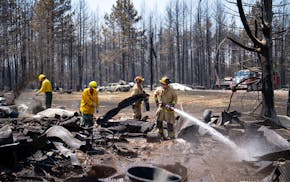Big changes are coming for drivers who transport children in their personal vehicles as rules governing the use of child safety seats, booster seats and restraints go into effect Thursday.
A change in Minnesota state law brings new guidelines in step with American Academy of Pediatrics recommendations, which are designed to prevent children from prematurely graduating to the next level of restraint.
"We all want our children to be as safe as possible while we're driving, and that means making sure they are in the proper child restraint," said Mike Hanson, director of the Minnesota Department of Public Safety's Office of Traffic Safety. "The new law lays out best practices and will help parents make the best decision to protect their child."
Crashes are one of the leading causes of serious injury and death for children 7 and younger. Between 2019 and 2023, preliminary data shows that 89% of the more than 12,800 children involved in an automobile crash in Minnesota but were restrained were not injured. Another 10% suffered minor injuries, DPS said.
Conversely, of the 20 children in that age range who died in wrecks over the same five-year period, only 10 were known to have been properly secured, DPS said. When it comes to injuries, only 44% of those seriously hurt were properly restrained, DPS said.
Until now, state law required car seats to be used according to the manufacturer's instructions on height and weight. The change in state law now specifies the age for using a rear-facing or forward-facing car or booster seat.
Here are the rules:
Birth to 2 years old: Must be in a rear-facing infant seat with an internal harness or convertible child safety seat.
Ages 2 to 4: A forward-facing seat with an internal harness can be used if the child has outgrown the rear-facing seat by height or weight.
Ages 4 to 9: A booster seat using a lap and shoulder belt may be used if the child has outgrown the forward-facing seat by height or weight. The age requirement for the booster seat has been extended from 8 to 9.
Ages 9 and older: Children of this age may wear a regular seat belt with a lap and shoulder strap provided they have outgrown requirements for the booster seat, the seat belt fits properly, the child's back is flat against the back of the seat and their feet can touch the floor. Safe Rides 4 Kids has developed a five-step seat belt fit test. All children 13 and younger must ride in the back seat of a vehicle if possible.
Children falling into more than one category must stay with the safer restraint, DPS said. For example, a child who is 2½ and weighs 35 pounds but has a rear-facing car seat limit of 40 pounds must stay in the rear-facing seat even though the child is old enough to move to a front-facing seat, DPS said.
The National Highway Transportation Safety Administration estimates about half of car seats are installed incorrectly, wiping out safety advantages. In Minnesota, several places offer free car seat checks. They are listed on the Office of Traffic Safety website.

31 Palestinians are killed heading to a Gaza aid site, witnesses say. Israel denies responsibility
Amtrak's Borealis beat ridership expectations in first year. Minnesota wants to build on its success.

Hot, dry weather challenges wildfire suppression efforts in northeastern Minnesota
Two people injured in shooting outside University of Minnesota arena released from hospital

